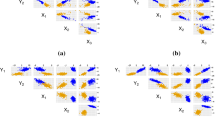Abstract
In this paper, we provide an overview on the underlying response variable (URV) model-based approach to cluster and, optionally, simultaneously reduce ordinal and, optionally, continuous variables. We summarize and compare its main features discussing some key issues. An example of application to real data is illustrated comparing and discussing clustering performances.
Access this chapter
Tax calculation will be finalised at checkout
Purchases are for personal use only
Similar content being viewed by others
References
Bock, D., Moustaki, I.: Item response theory in a general framework. In: Handbook of Statistics on Psychometrics. Elsevier, Amsterdam (2007)
Bouveyron, C., Brunet, C.: Model-based clustering of high-dimensional data: a review. Comput. Stat. Data Anal. 71, 52–78 (2012)
Browne, R.P., McNicholas, P.D.: Model-based clustering, classification, and discriminant analysis of data with mixed type. J. Stat. Plan. Inference 142(11), 2976–2984 (2012)
Cagnone, S., Viroli, C.: A factor mixture analysis model for multivariate binary data. Stat. Model. 12, 257–277 (2012)
Cai, J.H., Song, X.Y., Lam, K.H., Ip, E.H.S.: A mixture of generalized latent variable models for mixed mode and heterogeneous data. Comput. Stat. Data Anal. 55(11), 2889–2907 (2011)
Celeux, G., Govaert, G.: Gaussian parsimonious clustering models. Pattern Recognit. 28(5), 781–793 (1995)
Dean, N., Raftery, A.E.: Latent class analysis variable selection. Ann. Inst. Stat. Math. 62(1), 11–35 (2010)
Everitt, B.: A finite mixture model for the clustering of mixed-mode data. Stat. Probab. Lett. 6(5), 305–309 (1988)
Gollini, I., Murphy, T.: Mixture of latent trait analyzers for model-based clustering of categorical data. Stat. Comput. 24(4), 569–588 (2014)
Hunt, L., Jorgensen, M.: Clustering mixed data. Wiley Interdiscip. Rev. Data Min. Knowl. Discov. 1(4), 352–361 (2011)
Lawrence, C., Krzanowski, W.: Mixture separation for mixed-mode data. Stat. Comput. 6(1), 85–92 (1996)
Lubke, G., Neale, M.: Distinguishing between latent classes and continuous factors with categorical outcomes: class invariance of parameters of factor mixture models. Multivar. Behav. Res. 43(4), 592–620 (2008)
Marbac, M., Biernacki, C., Vandewalle, V.: Finite mixture model of conditional dependencies modes to cluster categorical data (2014, preprint). arXiv:1402.5103
Mardia, K.V., Kent, J.T., Hughes, G., Taylor, C.C.: Maximum likelihood estimation using composite likelihoods for closed exponential families. Biometrika 96(4), 975–982 (2009)
McLachlan, G.J., Rathnayake, S.I.: Mixture models for standard p-dimensional Euclidean data. In: Hennig, C., Meila, M., Murtagh, F., Rocci, R. (eds.) Handbook of Cluster Analysis, pp. 145–172. CRC Press, Boca Raton (2016)
McLachlan, G.J., Bean, R.W., Ben-Tovim Jones, L.: Extension of the mixture of factor analyzers model to incorporate the multivariate t-distribution. Comput. Stat. Data Anal. 51, 5327–5338 (2007)
McNicholas, P., Murphy, T.: Parsimonious Gaussian mixture models. Stat. Comput. 18(3), 285–296 (2008)
Morlini, I.: A latent variables approach for clustering mixed binary and continuous variables within a Gaussian mixture model. Adv. Data Anal. Classif. 6(1), 5–28 (2012)
Muthén, B.: A general structural equation model with dichotomous, ordered categorical, and continuous latent variable indicators. Psychometrika 49(1), 115–132 (1984)
Ranalli, M., Rocci, R.: Mixture models for ordinal data: a pairwise likelihood approach. Stat. Comput. 26(1), 529–547 (2016)
Ranalli, M., Rocci, R.: Standard and novel model selection criteria in the pairwise likelihood estimation of a mixture model for ordinal data. In: Wilhelm, A.F.X., Kestler, H.A. (eds.) Analysis of Large and Complex Data. Studies in Classification, Data Analysis and Knowledge Organization, pp. 53–68. Springer, Cham (2016)
Ranalli, M., Rocci, R.: Mixture models for mixed-type data through a composite likelihood approach. Comput. Stat. Data Anal. 110(C), 87–102 (2017). https://doi.org/10.1016/j.csda.2016.12.01
Ranalli, M., Rocci, R.: A model-based approach to simultaneous clustering and dimensional reduction of ordinal data. Psychometrika (2017). https://doi.org/10.1007/s11336-017-9578-5
Tipping, M.E.: Probabilistic visualisation of high-dimensional binary data. In: Proceedings of the 1998 Conference on Advances in Neural Information Processing Systems II, pp. 592–598. MIT Press (1999)
Varin, C., Reid, N., Firth, D.: An overview of composite likelihood methods. Stat. Sin. 21(1), 1–41 (2011)
Vermunt, J.K., Magidson, J.: Latent GOLD 4.0 User’s Guide. Statistical Innovations Inc., Belmont (2005)
White, A., Wyse, J., Murphy, T.B.: Bayesian variable selection for latent class analysis using a collapsed Gibbs sampler (2014, preprint). arXiv:1402.6928
Willse, A., Boik, R.: Identifiable finite mixtures of location models for clustering mixed-mode data. Stat. Comput. 9(2), 111–121 (1999)
Author information
Authors and Affiliations
Corresponding author
Editor information
Editors and Affiliations
Rights and permissions
Copyright information
© 2019 Springer Nature Switzerland AG
About this paper
Cite this paper
Ranalli, M., Rocci, R. (2019). An Overview on the URV Model-Based Approach to Cluster Mixed-Type Data. In: Greselin, F., Deldossi, L., Bagnato, L., Vichi, M. (eds) Statistical Learning of Complex Data. CLADAG 2017. Studies in Classification, Data Analysis, and Knowledge Organization. Springer, Cham. https://doi.org/10.1007/978-3-030-21140-0_5
Download citation
DOI: https://doi.org/10.1007/978-3-030-21140-0_5
Published:
Publisher Name: Springer, Cham
Print ISBN: 978-3-030-21139-4
Online ISBN: 978-3-030-21140-0
eBook Packages: Mathematics and StatisticsMathematics and Statistics (R0)




